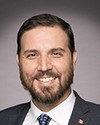Thank you, Mr. Chair.
Good afternoon, everyone. Thank you for the invitation to participate in today's session.
As you just heard, my name is Dr. Kamran Khan. I am BlueDot's founder and CEO. I'm joined by my colleague Alex Demarsh, who is BlueDot's director of data science.
I’d like to begin my opening remarks with some background information to help provide some important context for today’s conversation.
First, I'm an infectious disease physician and have been in clinical practice for the past 20 years. You may recall that 20 years ago a novel coronavirus that the world had never seen or heard of before emerged in Guangdong province in China and rapidly spread to more than two dozen countries around the world, including Canada. That virus was SARS-CoV. I started my career in the midst of that outbreak, and it is an experience I have never forgotten.
It has been the inspiration for everything I have done in the past 20 years of my career as a practising physician, including the past two years of this pandemic when I have been managing hospitalized and critically ill patients with COVID-19; as an epidemiologist and a professor studying outbreaks of emerging diseases and how they spread in our increasingly interconnected world; and as an entrepreneur who founded BlueDot eight years ago to harness the power of global data and modern digital technologies to strengthen our ability to respond to rapidly evolving outbreaks.
I’d like to be clear that BlueDot is an organization that produces infectious disease insights, not one that collects location data from mobile devices. Our sole purpose and reason for existence is to protect lives and livelihoods from the growing global threat posed by emerging infectious diseases.
To fulfill our mission, we procure and analyze diverse worldwide data from publicly and commercially available sources to better detect signals of outbreaks around the world at their earliest stages, to forecast their patterns of spread to cities around the world and to empower local responses that mitigate their health, economic and social consequences.
With COVID-19, we did just that. Our technology used publicly available data to detect a worrisome outbreak emerging in Wuhan back in late December 2019. We then accurately forecasted the global pathways of that outbreak through the worldwide network of flights, publishing our findings online in the world’s first peer-reviewed scientific study on COVID-19.
When COVID-19 began to spread here in our own country, we analyzed de-identified GPS location data that we procured from third party providers that we selected because they adhered to Canadian and other internationally stringent privacy laws and regulations and had strong data privacy practices in place.
These third party providers collect GPS data from mobile apps that have a logical need for location. The apps require express consent to use location data and provide users with the opportunity to withdraw such consent at any time. Note that any location data we receive from these third parties has been de-identified before it ever reaches our organization.
Some of these de-identified location data are also pre-aggregated before we receive them, while some data are delivered at the device level. We have never attempted to connect device-level data to an individual. We have no purpose for doing so and we are contractually prohibited from making any attempts to do so.
Working with the Public Health Agency during this pandemic, we have analyzed and transformed de-identified GPS location data into actionable public health insights to help anticipate epidemic surges, to inform where and when the utilization of finite resources will have the greatest impact on saving lives, and to understand the effectiveness of social distancing interventions, all under rapidly evolving emergency conditions.
Throughout our engagement, we have taken careful steps to ensure that any data or insights we have delivered to the Public Health Agency could not conceivably be associated with any individual.
I founded BlueDot because 20 years ago, as a frontline health care worker, I watched a virus cripple an entire city for four months. I understood then that more disruptive outbreaks would follow, and they have, with greater frequency, scale and impact.
Two years into this pandemic, I am certain that data, analytics and technology can help us stay ahead of outbreaks that we will inevitably face again and protect lives and our way of life. I am equally certain that we can continue to realize the value of such public health insights in a manner that fully respects and protects data privacy.
Thank you again for the invitation to be here today.



